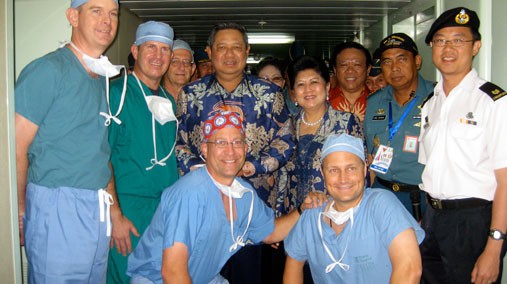Local Counterparts: Critical to Pacific Partnership Success in Indonesia

Tom Weinz served as the dedicated Foreign Service Liaison Officer for Pacific Partnership 2010 and Pacific Partnership 2011. He now serves as the dedicated Foreign Service Officer for Pacific Partnership 2012.
The Pacific Partnership Pre-Departure Site Survey (PDSS) team has just finished its work in the third of the four countries for 2012 -- Indonesia. Pacific Partnership as a program developed out of the tragic situation in December of 2004, when more than 230,000 people died following the deadly tsunami which struck many countries in the region, but Indonesia the most brutally. The U.S. Navy sent several ships to Indonesia in response, including USNS Mercy, and based on the lessons learned from that experience, initiated Pacific Partnership. Pacific Partnership returned to Indonesia in 2006, 2010, and upcoming in 2012.
After coordinating with the U.S. Embassy in Jakarta, we flew to the city of Manado, at the northernmost tip of the island of Sulawesi. Indonesia is a sprawling country of 16,000 islands; overlaid on a map of the United States, it would spread from coast to coast. Our team divided in two, with one group visiting prospective sites in and around Manado, and the other group traveling north by small boat as far as the island of Sangihe. These sites provide good, real world locations for humanitarian assistance/disaster relief exercises, but they also pose serious challenges for the PP12 mission. One of the greatest challenges is communication; our Indonesian counterparts are critical to both the site surveys and the mission itself, as they are fluent in Bahasa Indonesian, English, and sometimes more local languages or dialects.
In addition to surveying prospective sites for PP12, our teams include logistical and navigational experts. USNS Mercy, a converted tanker, is unable to approach most piers in the region; either the water nearby is too shallow, or the pier itself is unable to handle such a large vessel. The waters around Manado become so deep so quickly that Mercy cannot anchor off shore, so a plan must be created which allows Mercy to launch small boats and helicopters while at sea, and coordinate launches and recovery throughout each day. Landing sites have to be identified for boats and helicopters, and various support services need to be contracted, all during these initial survey visits.
We returned to Jakarta and held our final out-brief at the U.S. Embassy on December 6. The final PDSS visit to Vietnam, now being conducted by a smaller team than in the other countries, includes five members of the Japan Self Defense Force. As in PP10, Japan intends to send an accompanying amphibious ship to participate in Pacific Partnership 2012.
Share this post with others.
Posted under: East Asia and the Pacific
View Comments (1)
Tags: Indonesia (36) | Japan (65) | Pacific Partnership (29) | Vietnam (14) |

Comments
Ananda V. in New York writes:
Everytime I read things like this, my emotion and brain lights up like a christmas tree. Great jobs u guys...keep up with the good work. One love..One world.
Posted on Mon Dec 12, 2011